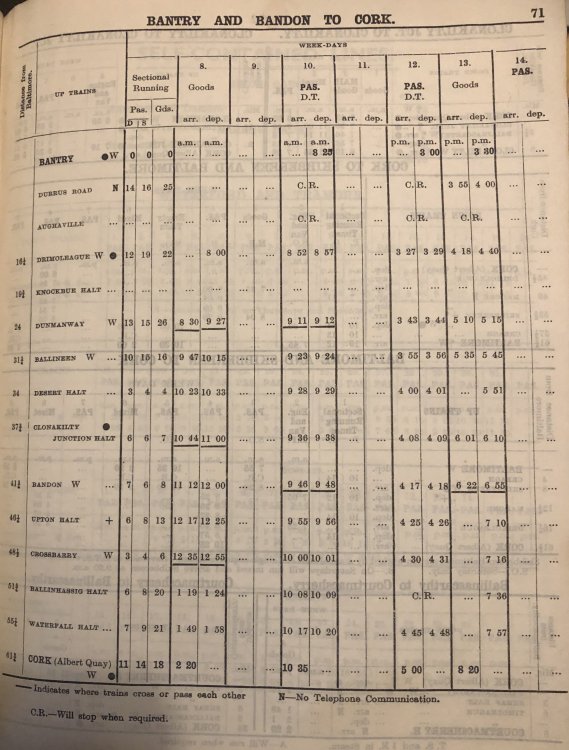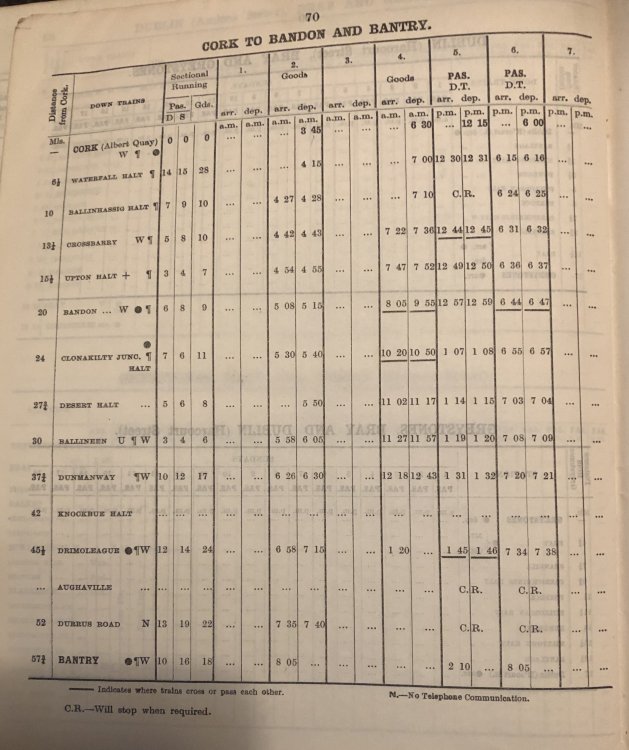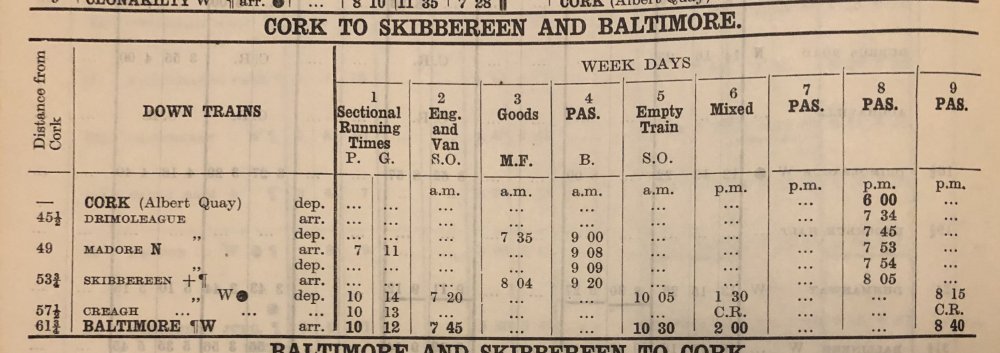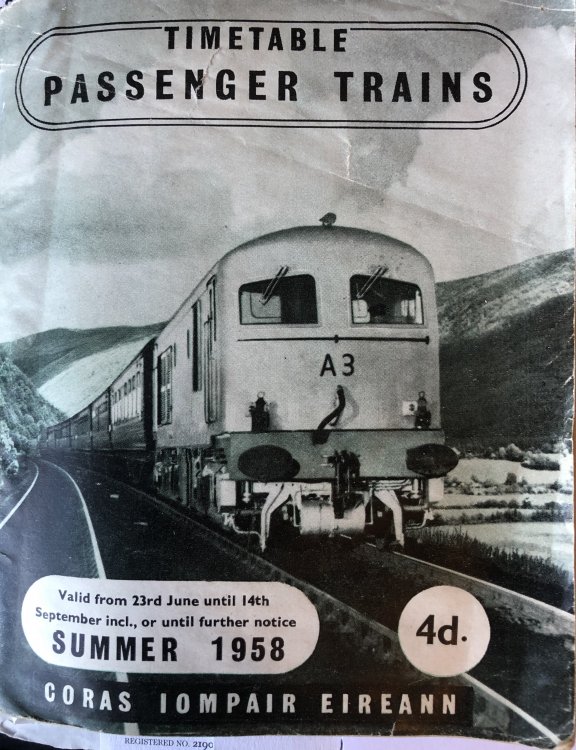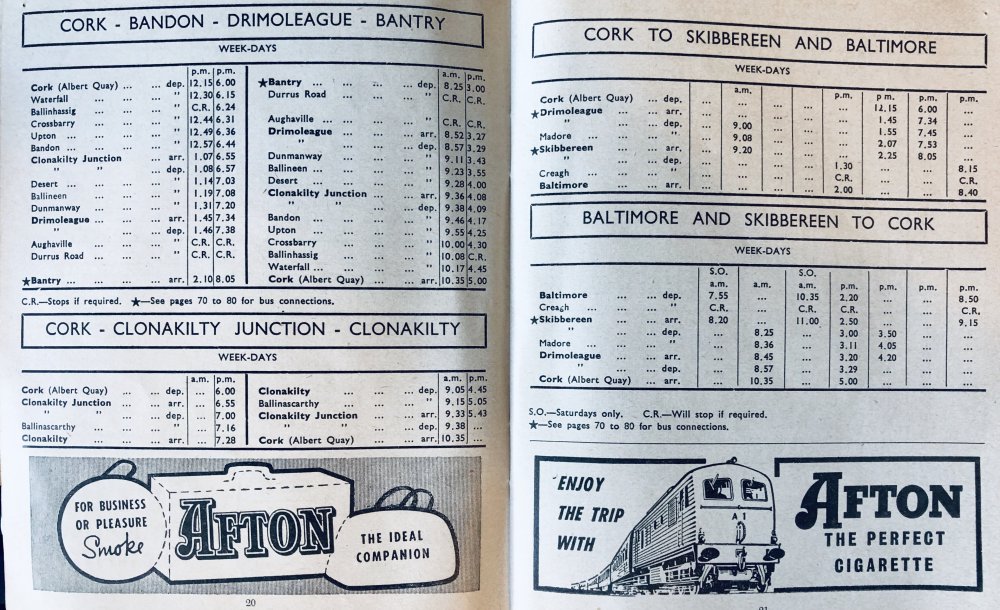-
Posts
15,438 -
Joined
-
Last visited
-
Days Won
374
Content Type
Profiles
Forums
Resource Library
Events
Gallery
Blogs
Store
Community Map
Everything posted by jhb171achill
-
Ach now.... My own distaste for all things "modduren" begins with 071s and Hunslet Enterprises. But each to their own; jhb171Senior would have looked blankly at a B101, B113, D class or Donegal Railcar and walked away..................they didn't breathe shteam! There will come a day, I do tell ye, when the baby gricelings of the day, once they pass pension age (101, as it will then be, under FFG) look back in nostalgia, and pore over old pictures of the ICRs and CAFs and 201s that they remembered their dads taking them on the last run of, before the global warming an'all that stuff. Senior also used to recall his time in Blackburn, Lancashire, as the Blackburn District PW Engineer, where he worked about 1939-44. The LMS men around him referred to the "Black 5's" as the "new engines", thus Senior saw them as such too.... It's all relative. Having said all that, no, I've no interest in ICRs either, but they're better than a greenway......
-
There can be few lines other than the main line which saw B101, B121, B141, A & C classes in that period. It seems that the AEC cars weren't regulars there either, unless I'm mistaken? All in all, then, an excellent candidate for a layout.....
-
The following is from 1955. Now this Is very interesting to compare with the 1930 (all-steam) and 1960 (all-diesel*) timetables. Here, the main line passenger trains are all diesel (AEC railcars), whereas ALL goods and branch mixed / passenger remain steam. (Bar the odd steam extra or substitution; all REGULAR services were diesel then). Some interesting observations. 1. Was there still a loco based at Courtmacsherry, of all places? I doubt it, yet the timetable has a loco and goods going out of there in the morning and coming back midday. I would have guessed that it would have been better to have the Clonakilty loco just take any goods in there from the junction, and go back later? If there was not a loco based there, then a loco and van would have had to go in there and out again in advance of, and after, the daily goods train. Where did it come from - Clon Junction? And if so, why is it not listed as a light working? 2. On the Clonakilty line, one engine, a goods van and a six-wheel passenger brake appear to have been stationed there. The loco and van do the first return trip, with the loco and brake coach doing the other two runs. 3. The railcar set does two return trips on the Cork - Bantry route - fine. But the goods - one return train from Albert Quay to Bantry and back, and one, on the face of it, to Drimoleague. However, what happens next beggars belief, as I had noticed before: 4. .....and that is this. Look at the Drimoleague to Baltimore service, crewing and locomotive requirements. It beggars belief that such complex and (to the travelling public) inefficient and downright pointless movements could replace rationality! The goods train could just continue and come back, a la Bantry, and a local passenger set could just do two workings from Baltimore to Drimoleague to meet the main line train there. But look.... firstly, apart from the disjointed workings during the day, which seem to treat Skibbereen to Baltimore as an entirely separate line, the 19:34 from Drimoleague only goes as far as Skibbereen. However, there is a 20:50 departure from Baltimore up to Skib and back, connecting with nothing. Does this mean that there is a loco stabled there (as late as 1955, anyway) just to do this? More likely, the 19:34 ex-Drimoleague just goes on to Baltimore light, but (a) why doesn't it just continue as a passenger train, and (b) why isn't any such working in the WTT? 5. It appears that the goods engine from Cork to Drimloleague just goes back to Cork. Why not continue to Baltimore and then go back? A crew change, if required, wouldn't exactly be rocket science to organise....... So, we have two locos on the Cork to Drim goods (they cross at Clon Jct), one on the Cork - Bantry return goods. A branch loco on the Clon and Court lines, apparently, and one or possibly two on Drim - Baltimore. Add a shunter at Albert Quay. Thus, without spare locos, the daily traffic requirement is some 7 or 8 locomotives, whereas after dieselisation this fell eventually to five "C" class. Five drivers instead of eight drivers, eight firemen and about 6 or 7 steam raisers. AND - they’re all the right way up! Howzat! Can we dare to imagine what a 121, a B101, an A or a modern ICR would have been like on the West Cork? In the 1960s and 70s, it is likely that the line would have been monopolised by 141s with three-coach laminate trains, possibly providing a home for tin vans into the 1980s. Goods - apart from beet, you might have had fert and Guinness, and possibly oil traffic from Bantry. Oil liners? Pairs or 071s into Bantry? We can but dream. I can't help feeling that ordinary goods traffic would have died in 1975/6, though maybe a container terminal at Bandon would have figured into the 1980s. Mind you, if open now, I daresay IE would treat it like Waterford to Limerick - doing their best to run it down by putting a 2600 on it, and substituting buses whenever they could!
-
CORRECTION: I'm just re-reading my original comment on a pair of 121s.... I said it was 1972 - that's a typo - it was 1973!
-
The train featured at 2:30 seems unusually long for this service - I wonder was there a story behind it? And at 6:12 onwards, we seem to have a B101 hauling a presumably deceased "C"! A superb video.
-
It was Indeed, that’s how I remember it. It was a midday or early afternoon stopping train to Cork, leaving what is now platform 5. The leading one anyway, but I think both, was newly painted in “supertrain”, the first time I had seen this livery in a 121. We we’re leaving my cousin onto the train to go to Mountrath..... happy days....
-
The first time I saw a 121 “pair” was in 1972 about to leave Heuston on an afternoon Cork departure.
-
Walker Diesel Class F - ECMbuild in 4mm for OOn3
jhb171achill replied to murrayec's topic in Irish Models
Mighty stuff!- 136 replies
-
- 1
-

-
- class f
- west clare
-
(and 1 more)
Tagged with:
-
Walker Diesel Class F - ECMbuild in 4mm for OOn3
jhb171achill replied to murrayec's topic in Irish Models
Maybe 15 years ago, most of the Irish models on sale now, both in kit and (especially) RTR form, would have been financially viable for a manufacturer. Now is the golden age of Murphy Models, IRM, Provincial, SSM, 00 Works, Silverfox, all according to taste, and others. I believe that the day may come (but not yet) when n-g stuff might be viable. Look at the 009 scene. In the 1980s when I started 009, you could only get highly expensice Austrian, Swiss or German stuff RTR. Anything British or Irish meant either scratchbuilding, or very crude "British" outline kits. Now we have absolutely superb RTR stuss. I suspect that a generic RTR van, as seen on the CDR, West Clare and so on, a T & D cattle truck, a Donegal / West Clare Walker railcar and perhaps a Donegal or Leitrim coach or two might be a start. In locos, a Dingle tank or a Donegal class 5 would be probably the most viable. I'd love to see it - though if it ever comes about, I suspect it's years ahead. A few years ago, even current Irish stuff was all confined to the 1970-present period. Now we are seeing 121s, "A"s, kits of A, B101, B141 and so on, plus RTR steam with Roderick's excellent U, UG and J15s. We now have Leslie's great range of wagon kits, probably undreamable within the last fifteen years. Here's hoping. To all Irish manufacturers, kit and RTR alike: congratulations, thank you and keep it up!- 136 replies
-
- 6
-

-

-
- class f
- west clare
-
(and 1 more)
Tagged with:
-
I think it was, Ben. I got a public one then as I was off on a summer holiday's worth of rail runabout travel. I will try to find it, although I have no idea where to start in this room!!! The idea was to shorten the trains but increase the service.
-
Weathering it with liberal oil stains might be a better option!
-
They’re actually newly painted green in that photo....... nice and shiny, though, as befitted the occasion! Anything still silver by then was absolutely disgracefully filthy, and probably well beyond cleaning to a remotely acceptable standard..... The “silver” era is never going to tax a modeller who isn’t confident about intricate lining! Just dip the whole thing in a puddle of random weathering stuff! Was looking just the other night at some of John Langfords’ and Roger Joanes’ superb photos from those times - there’s one somewhere showing a newly repainted “tin van” (green) coupled next to an identical van still in “silver”. It’s so dirty that it could have been painted tartan with pink and yellow spots for all anyone might know.....
-
I only have a handful of bus timetables, so I never thought to consult them. Thus, I was unaware that as WELL as the two trains, there were two buses.... Interesting! While it’s never occurred to me before, I wonder how buses generally served “about to be closed” as well as recently closed locations. What, for example, has the ‘56 bus timetable got to say about Kinsale and Macroom?
-
Walker Diesel Class F - ECMbuild in 4mm for OOn3
jhb171achill replied to murrayec's topic in Irish Models
Wowwww!!!!!- 136 replies
-
- 3
-

-

-
- class f
- west clare
-
(and 1 more)
Tagged with:
-
H Gricer, I suspect that you’re partly pointing your comments at me. If not, please forgive my incorrect assumption. If so, let me assure you that as a member of the IRRS for 45 years, and jhb171Senior being one of the first founding members, I have the greatest respect for the society’s activities. Many members (voluntary, as you say) have been of great assistance to me over many, many years, and several with whom I am in regular communication continue to be, with regard to future issues I’m researching. If your comments regarding “thinking carefully” before posting are slanted towards me, rest assured that I am well aware of how the society works internally, and I do indeed “think” before posting. I am not sure if you think that personally, I try to take “pops” at the society, but if so I will reiterate what I said above; as evidenced by agreeing this very day to do a couple of talks in the future. As a volunteer in the RPSI and DCDR for virtually all my teen and adult life, I know very well the machinations, let us say, of the innards of a voluntary railway-interest body. I know well the frustrations, successes, and commitments of what, and how, volunteers put into these things. Often, I sat at the top table at an AGM and had to listen to endless bitching, moaning and idiotic criticism of the voluntary activities and (volunteer) management decisions of the voluntary “workers” and, indeed (committee) “management” of both societies. Personally speaking, for me it was water off a duck’s back, and I thought (of the critic); “what would you know, I’ve a locomotive to light at 2 am on Saturday”.... or whatever! There are two sides to all issues. Just as it’s not good enough to constantly bitch at, and criticise unpaid volunteers (clearly, you’d agree with that), there may be times when some issues within a society may justifiably be at least mentioned. This includes ANY society. Your local golf club, the IRRS, ITG, RPSI or whoever. I do know, and I fully accept this is purely my own personal view, that when involved in RPSI and DCDR management for some 25 years, when I heard of undue or unfair criticism of matters within my remit (usually finance, dining cars, health & safety, or operations), I might well have whinged back (!) but I would have privately given consideration as to whether the critic actually had a point or not - even if I, or the committee, didn’t particularly want to hear it. The point here is that neither I (back in the day!), or any voluntary body I was involved in as a volunteer, or just a member of - is above criticism. I doubt that a solitary person here does not appreciate the efforts of all volunteers. The IRRS has been about for some 70 years, and thank goodness it has; the loss of material otherwise would be absolutely unthinkable. However, just as nonsensical criticism is at best pointless, and at worst plain wrong, it is reasonable to allow that every single policy they’ve ever had, or every single individual involved over 70 years, is unlikely always to be right. For any body, voluntary or not, to claim perfection (and I know you did not say this) would be equally nonsensical. Personally, I have never publicly posted my opinions (to which, like all, I am perfectly entitled, like you), on how any of the railway bodies, IRRS included, are run - and I won’t; I’m sure you’d agree it’s inappropriate. Nor, most certainly, have I ever named any individual in any of them, even if privately I would differ with their way of doing things. You mentioned “someone” using the expression “squirrelling away” about donations of photographic collections. Anyone reading all this stuff will appreciate that this was my comment. So, allow me to comment. At no stage did I mention the IRRS. I remain holding my opinions on the IRRS policy regarding photos to myself. I have not stated them here and will not - other than to make the positive comment that I am confident that, among other things, the current conservation activities - voluntarily - within the society, are very much advanced in recent years. There are a number of photographic repositories. They fall into six categories. First, three professional (NLI being one), and three private and / or voluntary (the IRRS and Ernie’s superb archive being examples). Within both of these headings, three sub-divisions. 1. Those who make their collections unconditionally available to the public. Ernie, much appreciated by all here, is one. 2. Those who make their stuff available, but perhaps with conditions (eg you have to be a member, or (Lawrence / O’Dea collections) on payment of a fee - absolutely fair enough, of course. 3. And - those who retain all material donated, disseminating it periodically, selectively, only to certain people or entities, or whatever. Thus, “squirrelling away”. In (1) and (2), 100%, sure, totally justified. In (3), people are perfectly entitled to opinions as to whether or not this is good practice. People are entitled to express their opinions, civilly. Again, I’ll keep my personal opinions to myself. However, should anyone else see fit to express dissatisfaction with the policy of either the IRRS, NLI or any other individual or entity in connection with its stewardship of its collections, this is not necessarily a personal attack on anyone, thus not at all ”slanderous”. I doubt if anyone here - certainly not me - has any intention of being slanderous. As far as I am personally concerned, I hope this clears the air. Now, maybe we’ll go back to West Cork, to keep on track, as it were, irrespective of 30 mph speed limits.....
-
Interesting. I was sure I found green on one of them some years ago.... !
-
They were slow. Various circulars survive showing very numerous slacks on already-slow track.
-
“Back in the day”, this was very much the case. One of my late uncles was an insurance salesman, whose working life would have started in the early 1930s, and he would travel about by train. He would arrive in some distant, exotic place like Navan or Carlow, and meet his client. A pot of tea or a sup of whiskey would follow, depending on the client, and they’d rarely get much business done before lunch. Late afternoon train back to Dublin. Point being: the business life of people back then was much more relaxed, without quite the same emphasis on rush hours as now. Had any of the CBSCR survived, an arrival in Cork by 9 at the latest would probably be obligatory. If operated by, say, a 4x 2600 or a 3x ICR, it’s interesting to speculate how long it would take from Bantry to Cork. Most of the smaller stops would probably be closed and at most he’d have one other train to cross.
-
By the end, according to several late enthusiasts who were experts on the west Cork lines, the dieselisation would obviously mean greatly reduced loco Dept. staffing on the system. This led to frequent forays of main line drivers and firemen when things got busy, e.g. the beet season. By 1961 there was but one “Bandon tank” serviceable, but it spent most of its time shunting Glanmire Road. As I’m sure most know, the pair of J30’s, 90 & 100, spent their last few years double-heading the summer specials between Clonakilty Jct and Courtmacsherry. I believe a “main line” engine brought them down to there from Cork. Once they put a “C” class on that duty (1958 or 9), that one wasn’t steam any more. 90 remained shunting Albert Quay and Glanmire for a couple of years more, and should shortly join the Q for a return to traffic at Downpatrick, releasing CSET No. 1 for a much-needed break. In the final days, steam was rare, with nothing regular after c. 1958. A GSWR tank engine or possibly 464 occasionally deputised for the railcar when it was away for maintenance. I could be wrong on this as it was a long time ago I was told, but the late James Boyd believed that this was every two to four weeks. The branch train towards the end was a new “tin van” and an old GSWR dide corridor bogie compo of 1910-20 era design - or - a GSWR 6-wheel passenger brake and a six wheel compo (ex-Midland, usually - a lot of old MGWR 6-wheelers ended their days in Cork). One of the great beauties of the “Green’n’Grey” era was the likelihood of seeing a branch train consisting of a six-month-old diesel hauling a brand new “tin van”, followed by an 1887 six-wheeled third and a 1915 bogie coach! Or, elsewhere, an 1887 steam engine hauling a brand new laminate and an 1892 wooden 6-wheel brake 3rd!
-
Yep, as far as passengers were concerned, that’s it!
-
True, Galteemore....... To go back to topic, the following public timetable (1958) makes it easier to work out passenger turns in West Cork. As you can see, some ECS workings were very much the norm. The entire Cork - Bantry service was worked by one AEC set - a necessary RTR thing, by the way, for the entire CIE and GNR systems, and a lot of the UTA & early NIR....
-
That carriage was scheduled for preservation by CIE but was scrapped! Had it survived, it would almost certainly have gone with “Maedb” and would now reside in Cultra.
-
Very true, minister - in my remark, no criticism of the voluntary work within the IRRS was intended as such.
-
The O'Dea collection, thankfully, is publicly available. Even before online platforms, you could make an appointment to go into the National Photographic Archive and browse O'Dea and Lawrence to your hearts content. J P O'Dea specifically wanted his pics to be seen, and rightly so, and this is precisely why he did not donate them to other places! It is good to have this, and Ernie's absolutely invaluable archive.
.png.c363cdf5c3fb7955cd92a55eb6dbbae0.png)

